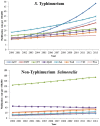Increasing Incidence of Salmonella in Australia, 2000-2013
- PMID: 27732615
- PMCID: PMC5061413
- DOI: 10.1371/journal.pone.0163989
Increasing Incidence of Salmonella in Australia, 2000-2013
Abstract
Salmonella is a key cause of foodborne gastroenteritis in Australia and case numbers are increasing. We used negative binomial regression to analyze national surveillance data for 2000-2013, for Salmonella Typhimurium and non-Typhimurium Salmonella serovars. We estimated incidence rate ratios adjusted for sex and age to show trends over time. Almost all states and territories had significantly increasing trends of reported infection for S. Typhimurium, with states and territories reporting annual increases as high as 12% (95% confidence interval 10-14%) for S. Typhimurium in the Australian Capital Territory and 6% (95% CI 5-7%) for non-Typhimurium Salmonella in Victoria. S. Typhimurium notification rates were higher than non-Typhimurium Salmonella rates in most age groups in the south eastern states of Australia, while non-Typhimurium rates were higher in most age groups elsewhere. The S. Typhimurium notification rate peaked at 12-23 months of age and the non-Typhimurium Salmonella notification rate peaked at 0-11 months of age. The age-specific pattern of S. Typhimurium cases suggests a foodborne origin, while the age and geographic pattern for non-Typhimurium may indicate that other transmission routes play a key role for these serovars.
Conflict of interest statement
The authors have declared that no competing interests exist.
Figures




References
MeSH terms
LinkOut - more resources
Full Text Sources
Other Literature Sources
Medical

